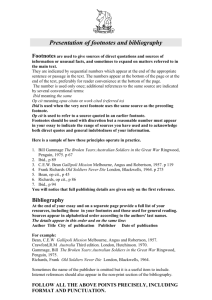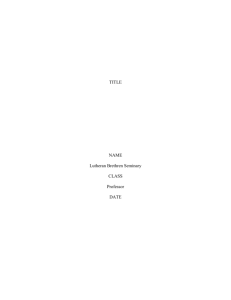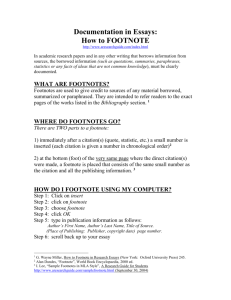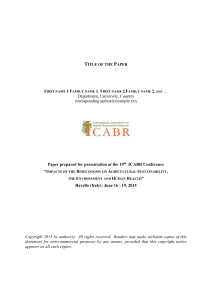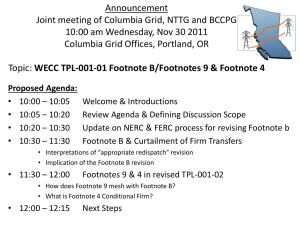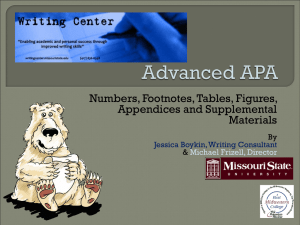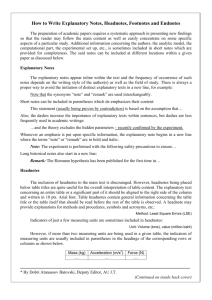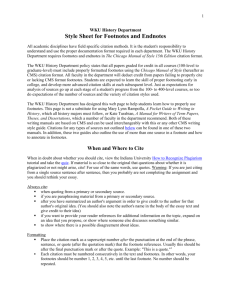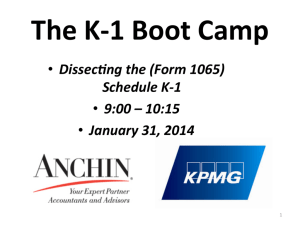nials journal of criminal law and justice
advertisement
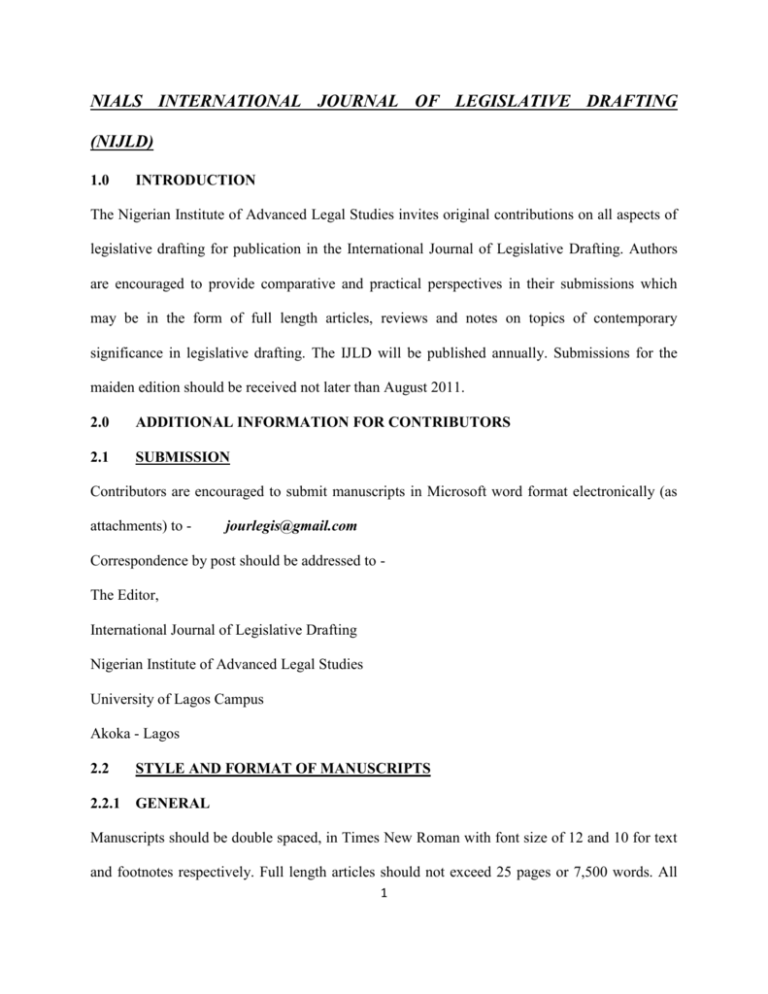
NIALS INTERNATIONAL JOURNAL OF LEGISLATIVE DRAFTING (NIJLD) 1.0 INTRODUCTION The Nigerian Institute of Advanced Legal Studies invites original contributions on all aspects of legislative drafting for publication in the International Journal of Legislative Drafting. Authors are encouraged to provide comparative and practical perspectives in their submissions which may be in the form of full length articles, reviews and notes on topics of contemporary significance in legislative drafting. The IJLD will be published annually. Submissions for the maiden edition should be received not later than August 2011. 2.0 ADDITIONAL INFORMATION FOR CONTRIBUTORS 2.1 SUBMISSION Contributors are encouraged to submit manuscripts in Microsoft word format electronically (as attachments) to - jourlegis@gmail.com Correspondence by post should be addressed to The Editor, International Journal of Legislative Drafting Nigerian Institute of Advanced Legal Studies University of Lagos Campus Akoka - Lagos 2.2 STYLE AND FORMAT OF MANUSCRIPTS 2.2.1 GENERAL Manuscripts should be double spaced, in Times New Roman with font size of 12 and 10 for text and footnotes respectively. Full length articles should not exceed 25 pages or 7,500 words. All 1 contributions must be accompanied with details of the author’s institutional affiliation, telephone and e-mail address. 2.2.2 FOOTNOTES All references should be in footnotes. Please note Always insert full stops after footnotes First line of footnote is indented; other lines aligned to the left Use ibid to refer to the footnote immediately preceding Footnotes start with capitals, except if they start with ‘n’ (note) e.g. ‘note 17 above’ If more than one source is cited in a footnote, list them chronologically (if no dates are available, list them alphabetically); separate sources with semi-colon i.e. ‘;’ No ‘paragraphs’ in footnotes Use ‘&’ when referring to articles and authors (arts 1 & 2; De Waal & Currie; Akintola & Others v Minister …); use ‘and’ in full sentences Journals are not abbreviated – provide full title, e.g. not “JAL”, but Journal of African Law 2.2.3 REFERENCE TO BOOKS (first reference): CH Heyns Human Rights Law in Africa ( Ibadan,: Spectrum, 2004) 333 (Note: title in initial caps and bold; author’s name not given, only initials; no space between initials) o (subsequent references): Heyns (note 2 above) 350 (no initial) o Two authors: CH Heyns & F Viljoen 2 2.2.4 REFERENCE TO JOURNAL ARTICLES When making reference to a Journal: Surname, Initial(s) Title of article (in initial caps), title of periodical in full, Volume (issue number) page numbers. For example – o Footnotes (first reference): E Bondzie-Simpson ‘A Critique of the African Charter on Human and Peoples’ Rights’ (1998) 31 Harvard Law Journal 643. o In footnotes (subsequent references): Bondzie-Simpson ( note 3 above) 644 o See paragraph 2.2.3 for two or more authors 2.2.5 REFERENCE TO CHAPTERS IN BOOKS Samuels, Alec. “Repealing or Amending Legislation by Non-legislative Means.” In Drafting Legislation: A Modern Approach, edited by Constantin Stefanou and Helen Xanthaki, 107- 118. England: Ashgate, 2008. In footnotes (subsequent references): Samuels (note 3 above) 110 or in the case of another chapter in a book referred to earlier: McLeod, Ian. “Legislative Intention” in Stefanou and Xanthaki ( note 3 above) 35 2.2.6 REFERENCE TO THESES AND DISSERTATIONS Unpublished: CH Heyns ‘Civil disobedience in South Africa …’ unpublished PhD thesis, University of the Witwatersrand, 1992 169 2.2.7 REFERENCE TO NEWSPAPER ARTICLES ‘INEC under fire over gubernatorial candidates’ the Nation 29 September 2010 p. 3 2.2.8 REFERENCE TO CASES Cases should be citied with the title in italics e.g. Egbe v Adefarasin [1985] 16 NSCC (Part 1) 1; if specific pages are referred to: Egbe v Adefarasin [1985] 16 NSCC (Part 1) 1 at 27. Note No full stops should be used in law reports’ abbreviations, e.g. ALLER, WLR, NWLR, WRN etc. 3 For subsequent references Egbe v Adefarasin (note 3 above) 2.2.9 REFERENCE TO LEGISLATION The Sexual Offences Act No 3 of 2006 (‘the Act’) See s.2 Criminal Procedure Act (CPA) Cap C41 LFN 2004. Write “section” in full if it starts the note. 2.2.10 REPORTS/PAPERS The title of a freestanding report, paper or statement should be enclosed in quotation marks, not italicised. 2.2.11 REFERENCE TO WEBSITES http://www.chr.up.ac.za (accessed 31 January 2005) When an author or article is cited, provide full information, eg Human Rights Watch ‘The death penalty debate’ 21 February http://................. (site accessed 31 March 2007). 2.2.12 CROSS-REFERENCING Footnotes referring to earlier footnotes should lead with the author’s surname (not her initials and surname as in the first reference) or the abbreviated name of a case or authorless policy document: Viljoen (note 16 above) 12-13. Grootboom (note 17 below) para 99. If the sentence to which the footnote attaches includes a reference to the author, case, or document, the format is: note 16 above, 12-13; note 17 below, para 99. If the sentence is to the immediately preceding note the format is: Ibid at 45 2.2.13 DATE FORMAT When making reference to a date: 31 January 2005 (not January 31st, 2005; 31 January, 2005) 4 2.2.14 NUMERALS Numbers should be separated by a hyphen and a space placed on each side of the hyphen: for example 150 000 - 290 000, not 150 000–290 000 or 150 000 – 290 000 all numbers less than ten (10) should be spelt out the word “percent” should be spelt out Spell out any number that begins with a sentence for example, “…Two Hundred people have been reported missing after the operation by the Police…” When referring to a figure within a sentence the numerals suffice, For example, “The police reported that 200 people were missing…” 2.2.15 PUNCTUATION Quotations: no full stop after the closing quotation mark Footnote reference in text: (footnote number should appear after full stop, comma or any the closing quotation mark) Avoid using ‘/’, rather use ‘or’ Bullets: If followed by full sentences, initial capital and full stop after each; if not full sentences, no initial cap and ‘;’ after each. 5

